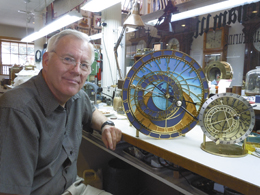 Amid the narrow aisles of Beacham’s Clock Company, it’s easy to get lost in the lull of constant ticking. Master clockmaker Ed Beacham has lived most of his life inside the cogs and gears of those antique clocks, but his latest project has taken him on a fascinating 600-year journey back in time.
Amid the narrow aisles of Beacham’s Clock Company, it’s easy to get lost in the lull of constant ticking. Master clockmaker Ed Beacham has lived most of his life inside the cogs and gears of those antique clocks, but his latest project has taken him on a fascinating 600-year journey back in time.
It’s a carefully researched reproduction of a 15th-century astronomical tower clock which resides in the Old Town Square in Prague. Named the Prague Orloj (pronounced Or-Loy), Czech townsfolk and international visitors have marveled at its mysterious assortment of interconnecting letters, numbers, dials and arms for half a millennium, often wondering what exactly it truly meant. The ancient astrolabe clock was created in 1410 by the genius horologist Mikulas of Kadan, working in conjunction with a mathematician at Charles University. Its design allowed for accurate readings of the zodiacal signs, sunrise and sunset times, even lunar phases of the moon. The actual position of the sun can be read from the projection of the sun hand onto the golden rim of the dial’s zodiac disk.
“This is such an amazing clock really, especially when you think of the technology and science at the time it was built,” said Beacham from his workbench at Beacham’s Clock Company.
“The full-sized dial is 10-12 feet is diameter and my reproduction, for practical purposes, is 15 1/2 inches in diameter. The outer ring tracks the length of the day and is adjusted seasonally. Its small “palm” hand designates the time of day on a 24-hour dial.”
Written in Latin on the dial are four words: ortus, aurora, occasus and crepusculum, meaning sunrise, dawn, sunset and twilight respectively. Artwork on the dial face traces the outline of the horizon. The lunar arm with its tiny mechanical orb gives you the exact phase of the moon as well as calculations for moon rise and moon set.
“Any good astronomer can look at the night sky and determine by the signs of the zodiac in relation to the North Star and determine what time of year it is,” explained Beacham.
The project began nearly two years ago with a phone call Beacham received from Savoy Glass in Portland who had a customer that wanted a special clock made and needed the mechanical pieces manufactured.
“So we ended up making two clocks, one three feet in diameter for Savoy’s client, and mine about half that size,” said Beacham. “Savoy put stained glass in theirs, where mine is painted metal by Cascade Graphics in Bend, which retains the original look and feel of the historic tower clock in Prague.”
The dial has all been finely craft from sheet aluminum using a water jet machine. The artwork was done in 24-carat gold plating.
“What’s incredible to me is how many millions of people have gone to Prague and stood looking up at this strange clock and had no idea what it did. When I first started on the project I didn’t know how it worked and had to construct a small discovery mockup for design purposes. Everything I thought I knew was wrong. All I had to work from were some detailed pictures and a research sheet listing the official specs of the original movement. Everything else I had to invent and that’s been one of the most fun parts of the whole process.”
Once the elaborate dial was built, Beacham then began work on the movement behind it.
“This is 1410 we’re talking about, it demands respect, so we designed a birdcage movement framework to stay true to what would have been inside a clock of that era. I had been to Riga, Latvia in 2001 to do some restoration work on an original birdcage movement and decided that’s what we would use for this clock.”
Through countless days and long nights, the clock gradually came together, a blending of old world craftsmanship and modern-aged ingenuity.
“I’m absolutely enthralled with the wisdom of these guys back then and how the clock did so many things,” he said. “Even the tiny lunar sphere has a counter-balance inside that allowed the shell to move.”
“Right now one of the novelties of the clock is that movements from the years 1280 to 1670 used what is called a “crown wheel” escapement to drive a pendulum. That kind of antiquity required it to stay true to the time period it was created. But they are not used much in modern clockmaking. For any clock collector or historian, looking at a crown wheel is like looking at a pretty girl.”
After the movement is completed, the next challenge was finding a suitable case to place it all in. Its age necessitated something gothic and medieval but it must not detract from the ornate beauty and complexity of the dial and its many hands and wheels. Beacham found himself wandering the aisles of his clock shop, looking for the best vessel for his new masterpiece. He found the perfect partner in the form of a six-foot, dark walnut, gothic-style grandfather clock standing right near the entrance.
In honor of his accomplishment, Beacham has been asked to give a presentation on his reproduction astronomical clock at the 2012 National Association of Watch and Clock Collectors’ national convention in Pasadena, California, where he will tell the story of the timepiece’s history and rebirth and unveil the completed clock to the audience.
“This has probably been the most challenging and enjoyable project I’ve ever worked on,” he said. “Especially being able to explain the heritage, the history and amazing culture of the Czech people.”
Beacham’s Clock Company can be found at 300 W. Hood St., 541-549-9971, www.beachamsclockco.com.





